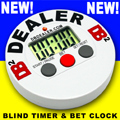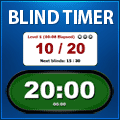|
|
How to Host a Large Poker Tournament
Host a poker tournament
Director-Training.com Most of the information on this site is geared towards hosting a home poker tournament of 8 - 20 players. If you are going to host a poker tournament of dozens or hundreds of players, here is a bit of information about how to run a large poker tournament. Don't Be the Tournament Director and PlayIf you host a poker tournament of more than two or three tables, you probably shouldn't play. As Tournament Director, you will be constantly moving players from one table to another and there will also be more rules disputes and dealer errors. You'll have quite a bit of running around to do. If you are also in charge of the food and beverages ... forget about it! Playing CardsYou can buy decks of paper cards (Bee, Bicycle) by the dozen. Make sure you check out local Sam's Club and Costco type of stores for big cartons of paper cards. You might also consider Royal Playing Cards, they can sometimes be found for a couple dollars per deck. They will last longer than a paper card but you shouldn't expect them to last more than one tournament. Purchasing decks of KEM, Copag, or other higher-end plastic cards is probably too expensive but would be a nice treat for the final table(s). You will need a dealer button at each table. The plain white dealer buttons can be purchased quite cheaply. Poker ChipsRemember this formula ... (8 x $25 chips) + (8 x $100 chips) = $1,000 in chips. There you go! Sixteen chips per player for a T1000 tournament. If you want to hold a T2000 tournament, simply add two $500 chips. If you want to hold a T5000 tournament, add a couple more $1,000 chips. Add in a $5,000 chip and you now have a T10,000 tournament. If you have lots of the $25 chips you could also use a (12 x $25) + (7 x $100) = 1,000 distribution. This is the chip distribution that is used by the WSOP. Remember that even if you do choose to use only $25 and $100 chips, you will still need some $500 chips to color-up towards the end of your tournament. You don't want any of those $25 chips in play when the blinds are $2000/$4000 and the minimum bet is $4,000. Let's say you are inviting 100 people over to your (very big!) house to play a T1000 poker tournament. 100 players are each issued 8 ($25) chips and 8 ($100) chips. You now have a total of 800 ($25) chips in play, amounting to $20,000. You need 40 ($500) chips to color-up all the ($25) chips in play. You also have 800 ($100) chips in play totaling $80,000. You need 160 ($500) chips to color-up all the ($100) chips in play. That means that you need a total of 200 ($500) chips to color-up all the ($25) and ($100) chips in play. Your final table will consist of ten players holding a total of 200 chips in play, 20 chips per player. This number of chips per player is a bit too low so you can rectify this by leaving some of the $100 chips in play. Chips from rebuys and add-ons will also add more chips into the game. So far we have 800 ($25) chips and 800 ($100) chips and 200 ($500) chips in our chipset - that's 1,800 chips to run a 100-player poker tournament with no rebuys or add-ons. You can probably count on almost every player buying an add-on. The number of rebuys is much harder to estimate but can approach 50% of the original buyins. Make sure to purchase additional poker chips to cover all the rebuys and add-ons but keep in mind that you can easily issue a couple high-denomination chips. A 1,000 chip rebuy/add-on can be issued using only 2 ($500) chips or 1 ($1,000) chip. Players can be asked to make change from other players. Since you will most likely need to purchase a set of 2,000 poker chips, but only need 1,800, you should purchase another 200 large denomination chips to accommodate rebuys and add-ons. A T1000 tournament with blinds starting at 25-25 is a bit harsh so you should probably start each player with 1,500 or 2,000 in chips rather than 1,000. This can be done quite easily by issuing one or two T500 chips along with the recommended (8x$25 + 8x$100) chips. Having 2,000 starting chips and starting blinds of 25-25 (quite common in large tournaments) will ensure a fair amount of play (80 big blinds to start the tournament). Buy some extra $500 and $1,000 chips to color up towards the end of the tournament. Here is a chip distribution for a large T2000 tournament ...
Poker Blinds Schedule
Your blinds schedule should be adjusted to allow for a low number of starting chips per player. Most large tournaments use a 25-100-500 progression in chips and blinds. Blinds usually start at 25-50 and sometimes at 25-25. The blinds levels increment by 25, then by 50, then by 100, and then by 1,000. Most large tournaments use an ante. The schedule to the right is a typical large tournament T1000 or T2000 blinds schedule. Like most of the blinds schedules that I recommend on this site, it is a little 'light' for the first levels. This allows inexperienced players a bit more time to catch on to how the game is played. This schedule is based on the Foxwoods NEPC Blinds Schedule that can be found on my Misc Blinds page. Several other large tournament blinds schedules can be found on that page. There are many levels in this schedule and it can be quite a nuisance to keep changing levels during a long tournament. Many tournaments will leave the blinds at 25-25 or 25-50 for the first hour and then go to something like 50-100 for the second hour, 100-200 for the third hour, etc.. Length of Your Poker TournamentMost large one-day tournaments last in the 6 - 8 hour range but can easily stretch to 8 - 10 hours. You will probably need one food/meal break and a couple other smaller breaks. Take your first break at the end of your rebuy period, usually an hour or two into the tournament. Poker PayoutYou should pay out much more than the top four or five players. You can make things simple by paying out all the players who make the final table. Most tournaments seem to pay out anywhere from 30% - 45% to the winner. The second place winner gets about half of what the winner takes, and the third place finisher takes about half of second place. The payout is then spread out amongst the remaining winners. If you decide to payout the entire final table, make sure you play hand-for-hand just before you are about to combine the final two tables. Players at one table might begin to play slower, hoping that a player from the other table will bust out. Moving Poker PlayersPre-determine how you will break up your tables. If you start with 10 tables of 10 players at each table, you might want to go down to 6 tables when you reach 60 players remaining in the tournament, 4 tables at 40 players, 3 tables at 30 players, 2 tables at 20 players and the final table at 10 players. You should try to break up your tables during coffee breaks whenever possible. Seating Poker PlayersMark each table as A, B, C, D, etc.. When you issue the starting chips to each player, include a little piece of paper with a seat assignment. A1 sits at the first seat to left of the dealer at table A, D8 sits eight seats from the dealer at table D, etc.. You can use Ziploc bags to store each players' chips and seat assignment. Poker Chip ImportingYou must be wary of players who cheat by bringing their own poker chips into your tournament. A player who puts a couple of his own yellow dice/suited chips in his pocket before he leaves home can greatly influence play if the $1000 chips you use in your tournament are also yellow dice/suited chips. Try to mark your chips in some way to differentiate them from common, everyday chips. Security of Poker ChipsYou will need to keep your extra chips in a secure case of some kind. You don't want players to have access to chips. Security of Poker GuestsRemember that you might have several thousand dollars in the tournament purse. Make sure you have a secure box or safe to store your money. Keep in mind that your poker tournament is an easy 'mark' for a robbery by professional thieves. Also remember that you might have a winner leaving, late at night, with several thousand dollars in his pocket. Tipping Poker DealersIt is a somewhat common practice at some tournaments to offer an additional $200 in chips for each player who contributes a $5 tip that goes to the dealer at that table. Ten players each contributing $5 means a $50 tip for the dealer. Players who do not contribute the extra $5 do not get the extra 200, or whatever amount you choose, in chips. Be aware that it may be illegal to do this in your area. |
|||||||||||||||||||||||||||||||||||||||||||||||||||||||||||||||||||||||||||||||||||||||||||||||||||||||||
Online Poker Guide
Hand Converter
Holdem strategy
Freeroll tournaments
Poker calculator
Online poker
Poker rooms
> poker pokeren
> iDeal poker
> online casino
> iDeal casino
> casino casinos
> casino bonus
Get Bonus code Titan Poker, and full tilt poker referral code or max bonus to the full tilt referral code. Best ultimate bet referral code sign up bonus doyles room promo code or poker host bonus code























